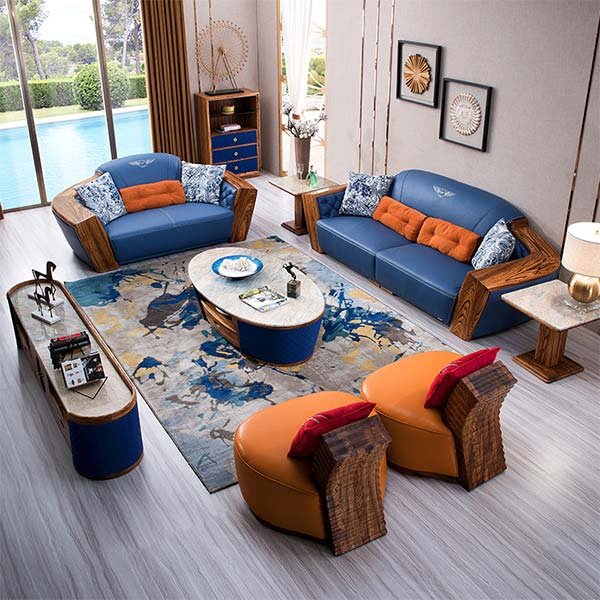“Harmony in Nature, Beauty in Sustainability: Embrace Wooden Furniture for a Greener Lifestyle.”
Benefits of using wooden furniture in sustainable living
Wooden furniture has been a staple in homes for centuries, and for good reason. Not only does it add a touch of warmth and elegance to any space, but it also has numerous benefits when it comes to sustainable living. In this article, we will explore the various advantages of using wooden furniture in sustainable living.
One of the primary benefits of wooden furniture is its durability. Unlike other materials such as plastic or metal, wooden furniture is built to last. With proper care and maintenance, wooden furniture can withstand the test of time, reducing the need for frequent replacements. This longevity contributes to sustainable living by reducing waste and the consumption of resources.
In addition to its durability, wooden furniture is also biodegradable. When it reaches the end of its life cycle, wooden furniture can be easily disposed of without causing harm to the environment. Unlike synthetic materials that take hundreds of years to decompose, wood naturally breaks down and returns to the earth. This makes wooden furniture a more sustainable choice compared to furniture made from non-biodegradable materials.
Furthermore, wooden furniture has a lower carbon footprint compared to furniture made from other materials. The production of wooden furniture requires less energy and emits fewer greenhouse gases compared to the manufacturing processes of plastic or metal furniture. Additionally, wood is a renewable resource, as trees can be replanted and harvested sustainably. This means that the use of wooden furniture helps to reduce the depletion of natural resources and contributes to the overall health of the planet.
Another advantage of using wooden furniture in sustainable living is its versatility. Wood can be easily repurposed and transformed into different furniture pieces, allowing for creativity and customization. This versatility extends the lifespan of wooden furniture, as it can be adapted to fit changing needs and styles. By choosing wooden furniture, individuals can reduce the demand for new furniture production and minimize waste.
Moreover, wooden furniture has a timeless appeal that transcends trends and fads. Unlike furniture made from synthetic materials, wooden furniture never goes out of style. This means that investing in wooden furniture is a long-term decision that will not require frequent replacements due to changing aesthetics. By choosing wooden furniture, individuals can create a sustainable living space that is both timeless and environmentally friendly.
In conclusion, the benefits of using wooden furniture in sustainable living are numerous. From its durability and biodegradability to its lower carbon footprint and versatility, wooden furniture offers a range of advantages that contribute to a more sustainable lifestyle. By opting for wooden furniture, individuals can reduce waste, conserve resources, and create a timeless and eco-friendly living space. So, the next time you are furnishing your home, consider the many benefits of wooden furniture and make a choice that aligns with sustainable living.
How to choose eco-friendly wooden furniture for your home
Wooden furniture has long been a popular choice for homeowners due to its timeless beauty and durability. However, in today’s world, where sustainability is a growing concern, it is important to consider the environmental impact of the furniture we choose for our homes. In this article, we will explore how to choose eco-friendly wooden furniture for your home.
When it comes to eco-friendly wooden furniture, the first thing to consider is the source of the wood. Opt for furniture made from sustainably harvested wood, such as FSC-certified or reclaimed wood. These types of wood ensure that forests are managed responsibly and that no new trees are cut down unnecessarily.
Another important factor to consider is the type of finish used on the furniture. Traditional finishes, such as varnishes and lacquers, often contain harmful chemicals that can be released into the air over time. Look for furniture that is finished with natural, non-toxic finishes, such as plant-based oils or waxes. These finishes not only protect the wood but also contribute to a healthier indoor environment.
In addition to the source of the wood and the finish, it is also important to consider the manufacturing process of the furniture. Look for furniture that is made using low-impact production methods, such as water-based adhesives and non-toxic dyes. Avoid furniture that is made with formaldehyde-based glues or other harmful chemicals.
Furthermore, consider the durability of the furniture. Investing in high-quality, well-made wooden furniture means that it will last longer and reduce the need for replacement. This not only saves you money in the long run but also reduces the demand for new furniture production, which can be resource-intensive.
When choosing eco-friendly wooden furniture, it is also worth considering the design and functionality of the piece. Opt for furniture that is versatile and can be used in multiple ways or in different rooms of your home. This way, you can maximize its use and reduce the need for additional furniture.
Additionally, consider the maintenance requirements of the furniture. Look for furniture that is easy to clean and maintain, as this will prolong its lifespan and reduce the need for harsh cleaning chemicals. Avoid furniture that requires frequent refinishing or treatments, as these can be both time-consuming and environmentally harmful.
Lastly, consider the overall aesthetic of the furniture and how it fits into your home’s decor. Eco-friendly wooden furniture comes in a variety of styles and designs, so you can find something that suits your personal taste and complements your existing furniture and decor.
In conclusion, choosing eco-friendly wooden furniture for your home is an important step towards sustainable living. By considering the source of the wood, the type of finish, the manufacturing process, the durability, the design and functionality, and the maintenance requirements, you can make an informed decision that aligns with your values and contributes to a healthier planet. So, next time you are in the market for new furniture, take the time to choose eco-friendly options that will not only enhance the beauty of your home but also support a more sustainable future.
Creative ways to upcycle and repurpose wooden furniture for a sustainable lifestyle
Wooden furniture has long been a staple in homes around the world. Its timeless beauty and durability make it a popular choice for many homeowners. However, as the world becomes more conscious of the need for sustainable living, finding creative ways to upcycle and repurpose wooden furniture has become increasingly important.
One of the most creative ways to repurpose wooden furniture is by transforming it into something completely different. For example, an old wooden dresser can be turned into a unique and functional kitchen island. By adding a countertop and some storage shelves, you can create a beautiful and practical addition to your kitchen. This not only saves money but also reduces waste by giving new life to an old piece of furniture.
Another way to upcycle wooden furniture is by giving it a fresh coat of paint or stain. This can completely transform the look of a piece and give it a new lease on life. For example, a worn-out wooden chair can be painted in a vibrant color and used as a statement piece in a living room or bedroom. By repurposing furniture in this way, you can add a personal touch to your space while also reducing the demand for new furniture.
In addition to repurposing furniture, there are also creative ways to upcycle wooden scraps. Instead of throwing away small pieces of wood, they can be used to create unique home decor items. For example, wooden scraps can be turned into coasters, picture frames, or even wall art. By using these scraps, you can add a touch of rustic charm to your home while also reducing waste.
When it comes to sustainable living, it’s important to consider the materials used in furniture production. Opting for reclaimed or salvaged wood is a great way to reduce the environmental impact of your furniture choices. Reclaimed wood is sourced from old buildings or furniture, while salvaged wood is collected from trees that have fallen naturally. By using these materials, you can help preserve forests and reduce the demand for new wood.
Furthermore, choosing furniture made from sustainably sourced wood is another way to promote sustainable living. Look for furniture that is certified by organizations such as the Forest Stewardship Council (FSC), which ensures that the wood used comes from responsibly managed forests. By supporting companies that prioritize sustainable practices, you can make a positive impact on the environment.
In conclusion, upcycling and repurposing wooden furniture is a creative and sustainable way to decorate your home. By transforming old pieces into something new, giving them a fresh coat of paint, or using wooden scraps for DIY projects, you can add a personal touch to your space while also reducing waste. Additionally, choosing furniture made from reclaimed or sustainably sourced wood helps preserve forests and promotes sustainable living. So, the next time you’re considering buying new furniture, think about the creative possibilities of upcycling and repurposing wooden furniture for a more sustainable lifestyle.
Заключение
Заключение: Исследование показывает, что существует тесная связь между деревянной мебелью и устойчивым образом жизни. Дерево является природным, возобновляемым ресурсом, который может быть использован для создания долговечной и экологически чистой мебели. Производство деревянной мебели также имеет меньший углеродный след, чем мебель, изготовленная из искусственных материалов. Кроме того, деревянная мебель может быть переработана и восстановлена, что способствует уменьшению отходов и продлению ее срока службы. В целом, использование деревянной мебели способствует устойчивому образу жизни и содействует сохранению окружающей среды.



